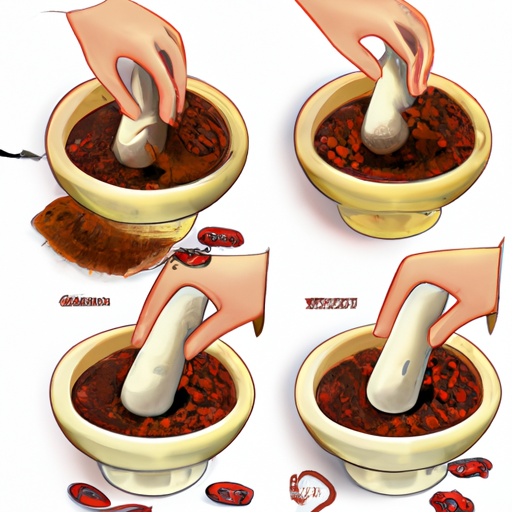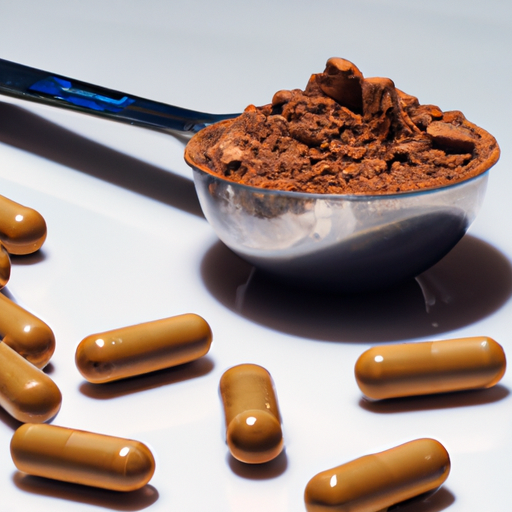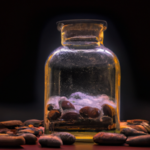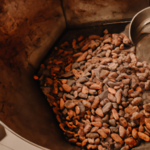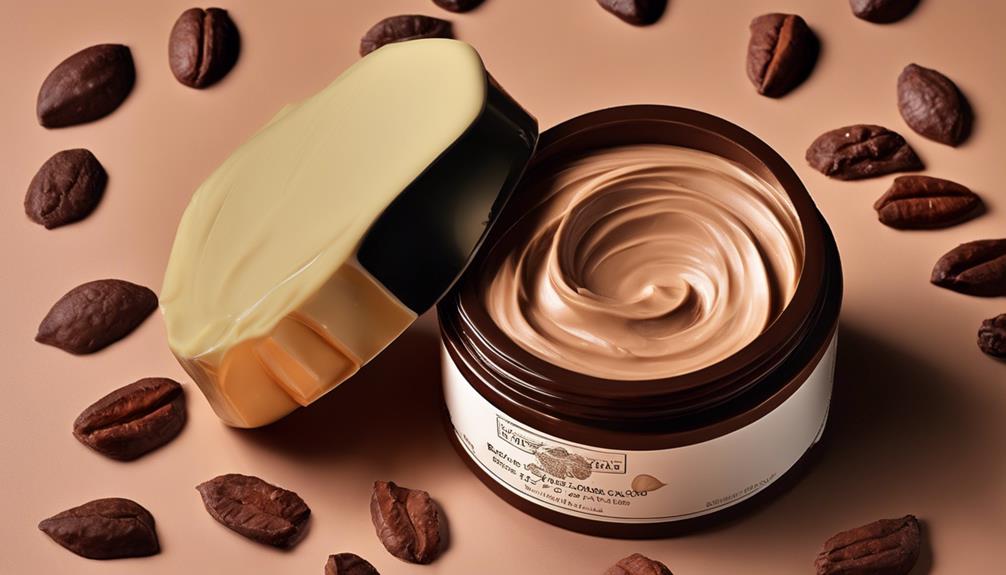I have stumbled upon a discovery that has revolutionized my culinary creations: powdered cacao beans. This wondrous ingredient has the power to elevate any dish from ordinary to extraordinary, with its rich and complex flavor profile.
But where can one find such a precious gem? Fear not, for I am here to guide you through the process of powdering raw cacao beans, unlocking the full potential of this heavenly ingredient.
In this article, we will delve into the benefits of using powdered cacao beans, as well as how to source and select the highest quality beans.
I will reveal my secret techniques for preparing and grinding the beans to achieve the perfect consistency.
And once you have your powdered cacao in hand, I will inspire you with creative ways to incorporate it into your favorite recipes.
So, gear up and get ready to embark on a delightful journey into the world of powdered cacao beans. Your taste buds will thank you for it. Let’s begin!
Key Takeaways
- Thoroughly dry the beans to prevent clumping
- Store powdered cacao in an airtight container in a cool, dark place
- Retains more nutrients in raw cacao powder
- Boost of antioxidants when added to smoothies
Understanding the Benefits of Powdered Cacao Beans
If you’re a chocolate lover like me, you’ll be thrilled to know that powdered cacao beans come with a whole host of amazing benefits!
The health benefits of powdered cacao beans are truly remarkable. They are packed with antioxidants, which help protect our cells from damage caused by free radicals.
Additionally, powdered cacao beans are a great source of essential minerals, such as magnesium, iron, and zinc. These minerals are vital for various bodily functions, including maintaining healthy bones and boosting the immune system.
Furthermore, powdered cacao beans are rich in flavonoids, which have been linked to improved cardiovascular health.
With their impressive nutritional value, powdered cacao beans are a fantastic addition to any diet.
Now, let’s delve into the next section about sourcing and selecting quality cacao beans.
Sourcing and Selecting Quality Cacao Beans
When you’re on the hunt for the perfect ingredients, sourcing and selecting high-quality cacao beans is like embarking on a thrilling treasure hunt. It is crucial to choose beans that exhibit the best flavor profiles for a truly exceptional powdered cacao experience. Here are some sourcing tips to ensure you find the best cacao beans:
- Look for beans sourced from renowned cacao-growing regions such as Ecuador, Madagascar, or Venezuela.
- Opt for organic and fair trade certifications to support sustainable farming practices and ensure ethical sourcing.
- Consider the fermentation and drying processes, as these can greatly impact the flavor development of the beans.
- Seek out specialty cacao bean suppliers who prioritize quality and consistency in their offerings.
By carefully sourcing and selecting quality cacao beans, you lay the foundation for a remarkable powdered cacao journey.
In the next section, we will explore the essential steps in preparing the cacao beans for powdering.
Preparing the Cacao Beans for Powdering
When preparing cacao beans for powdering, I first sort and clean the beans to ensure only the highest quality ones are used. This involves removing any debris, such as rocks or twigs, and discarding any beans that are discolored or damaged.
Next, I roast the beans to enhance their flavor and aroma. This step is crucial in developing the rich chocolatey notes that we associate with cacao.
Finally, I carefully remove the bean shells to extract the nibs, which are then ground into a fine powder. This process requires precision and attention to detail to achieve the desired result.
Sorting and Cleaning the Beans
To properly sort and clean the beans, you should begin by carefully inspecting each cacao bean for any impurities or defects. This is a crucial step in the process as it ensures that only the highest quality beans are used for powdering.
Cleaning techniques can vary, but a common method involves rinsing the beans under cold water to remove any dirt or residue.
Sorting methods can include manually removing any discolored or damaged beans, as well as separating the beans based on size and shape. This meticulous process guarantees that only the best beans make it to the next stage.
Once the beans are sorted and cleaned, they are ready to be roasted for optimal flavor, enhancing the rich taste that will be highlighted in the final product.
Roasting the Beans for Optimal Flavor
After carefully sorting and cleaning the high-quality beans, it’s time to roast them to perfection, unlocking their optimal flavor and creating a rich and aromatic experience. Roasting techniques play a crucial role in developing the flavor profiles of cacao beans. The temperature and duration of the roast can greatly affect the final taste and aroma.
During the roasting process, the beans undergo a series of chemical reactions that transform their flavor compounds. The Maillard reaction, for example, creates a delightful combination of caramel, nutty, and chocolatey notes. Additionally, roasting reduces the beans’ bitterness, making them more palatable.
To achieve the desired flavor, one must choose the appropriate roasting technique. Some prefer a slow roast at lower temperatures for a longer time, while others opt for a higher temperature for a shorter duration. Each method yields different flavor profiles, allowing for a diverse range of taste experiences.
Next, we will explore the process of removing the bean shells, which is the next crucial step in powdering raw cacao beans.
Removing the Bean Shells
Now, you can easily remove the protective outer shells of the beans, revealing the hidden treasure inside.
Removing bean shells is an essential step in the process of powdering raw cacao beans.
To begin, place the roasted beans in a clean cloth and gently rub them together. This friction helps loosen the shells, making them easier to remove.
Alternatively, you can use a small kitchen appliance or a manual grinder specifically designed for this purpose. By grinding the cacao beans, you not only break them into smaller pieces but also separate the shells from the nibs. This process ensures that only the pure cacao nibs remain, ready to be transformed into a smooth, fine powder.
Transitioning into the subsequent section, grinding the cacao beans releases their rich aroma and oils, intensifying the flavor of the final product.
Grinding the Cacao Beans
As I grind the cacao beans, their rich aroma fills the air, transporting me to a chocolate lover’s paradise. Grinding the cacao beans is a crucial step in the process of powdering raw cacao beans.
There are various grinding techniques that can be used, depending on the desired texture and consistency of the final product. One popular method is to use a grinder specifically designed for cacao beans, which ensures a fine and even grind. Alternatively, a mortar and pestle can be used for a more hands-on approach, allowing for greater control over the grinding process.
It’s worth noting that cacao beans can also be ground using a food processor, although this method may result in a slightly coarser texture. Beyond powdering, cacao beans can also be ground to create cacao nibs, which are often used as a topping or ingredient in various dishes.
Now that the cacao beans have been ground to perfection, it’s time to move on to storing and preserving the powdered cacao beans, ensuring their freshness and flavor are retained.
Storing and Preserving the Powdered Cacao Beans
To ensure the freshness and flavor of your powdered cacao beans are retained, it’s important to store and preserve them properly. Storing techniques play a vital role in extending the shelf life of powdered cacao beans.
Firstly, it is crucial to keep the beans in an airtight container, preferably made of glass or metal, to prevent moisture and air from degrading the quality. Additionally, storing the container in a cool, dark place, such as a pantry or cupboard, helps maintain the beans’ integrity.
Avoid exposing the powdered cacao beans to direct sunlight or heat, as they can cause the beans to lose their flavor and aroma. By following these storing techniques, you can ensure that your powdered cacao beans remain fresh and flavorful for an extended period.
Now, let’s explore some creative ways to use powdered cacao beans in your culinary adventures.
Creative Ways to Use Powdered Cacao Beans
You can sprinkle the magical dust of powdered cacao beans into your recipes, transforming them into a decadent symphony of rich flavors and velvety textures. The versatility of powdered cacao beans goes beyond the kitchen, opening up a world of creative possibilities. One way to utilize this chocolatey goodness is by making your own DIY cacao lip balm. Mix a tablespoon of powdered cacao beans with beeswax, coconut oil, and a touch of honey for a natural and indulgent lip balm that will leave your lips feeling soft and nourished. Another way to incorporate powdered cacao beans is by adding it to your smoothies. Not only does it add a delicious chocolatey taste, but it also provides a boost of antioxidants and nutrients. Experiment with different fruits and superfoods to create your perfect cacao-infused smoothie. Discovering the diverse world of cacao powder varieties will further elevate your culinary adventures.
Exploring Different Cacao Powder Varieties
Indulge in a world of culinary delights by exploring the wide array of cacao powder varieties available to elevate your chocolate creations.
When exploring different cacao powder flavors, it is essential to consider the nutritional benefits of each variety. For instance, natural cacao powder contains a higher concentration of antioxidants, which can promote cardiovascular health and reduce inflammation.
On the other hand, Dutch-processed cacao powder undergoes a treatment process that reduces its acidity, resulting in a smoother flavor profile. Additionally, raw cacao powder retains more of its natural nutrients due to minimal processing.
By comparing the nutritional benefits of different cacao powder varieties, you can choose the one that aligns with your dietary preferences and enhances the taste of your chocolate creations.
Transitioning into the subsequent section about troubleshooting common issues, let’s address some challenges that may arise during the powdering process.
Troubleshooting Common Issues
If you encounter any hiccups along the way, fear not, as we’ll now address some common challenges that may arise during the process.
Troubleshooting common issues is essential to ensure a successful experience in powdering raw cacao beans. One frequent problem is clumping, which can be prevented by thoroughly drying the beans before grinding. Moisture is the enemy here, so make sure the beans are completely dry to prevent clumping.
Another concern is maintaining freshness and flavor. To achieve this, store the powdered cacao in an airtight container in a cool, dark place. Avoid exposing it to heat, light, or moisture, which can degrade its quality.
Now that we have covered troubleshooting common issues and ensuring freshness, let’s dive into experimenting with cacao powder in other applications.
Experimenting with Cacao Powder in Other Applications
In this discussion, I’ll explore the various applications of cacao powder beyond its traditional use in desserts.
Firstly, let’s delve into the realm of DIY beauty products. Cacao powder can be used to create nourishing face masks and scrubs that provide both hydration and exfoliation for the skin.
Moving on, let’s investigate how cacao powder can be incorporated into savory dishes. By adding cacao powder to recipes, you can introduce a depth and complexity that enhances the overall flavor profile.
Lastly, let’s explore the use of cacao powder as a natural food coloring. With its rich and earthy hue, cacao powder can provide a beautiful and natural coloring option for a variety of culinary creations.
By experimenting with cacao powder in these alternative applications, you can discover new and exciting ways to enjoy its unique flavor and benefits.
DIY Beauty Products (e.g., face masks, scrubs)
Create your own beauty products at home using natural ingredients like raw cacao beans. DIY lip balm and homemade body butter are just a few examples of the endless possibilities.
Raw cacao beans are rich in antioxidants, vitamins, and minerals that nourish and rejuvenate the skin. To make a DIY lip balm, melt cocoa butter and coconut oil together, then add powdered raw cacao beans for a natural chocolate scent.
For a homemade body butter, combine shea butter, cocoa butter, and a few tablespoons of powdered raw cacao beans for a luxurious, moisturizing treat. The raw cacao beans provide a gentle exfoliation and leave the skin feeling soft and smooth.
These natural beauty products are a great way to pamper yourself and indulge in the benefits of raw cacao.
Now, let’s explore how to incorporate cacao powder in savory dishes.
Cacao Powder in Savory Dishes
After exploring the world of DIY beauty products, I’m excited to delve into the realm of using cacao powder in savory dishes. Cacao powder, derived from raw cacao beans, adds a unique and rich flavor profile to a variety of culinary creations.
It can be used to enhance salad dressings, giving them a subtle yet distinct chocolatey taste. Additionally, incorporating cacao powder into soups can provide a depth of flavor that is both unexpected and delightful.
To make the most of this versatile ingredient, consider the following:
- Use cacao powder sparingly to avoid overpowering the dish.
- Experiment with different combinations of herbs and spices to complement the cacao flavor.
- Consider adding cacao powder towards the end of the cooking process to preserve its delicate taste.
- Remember that cacao powder is a natural thickener, so adjust the consistency of your dish accordingly.
- Don’t be afraid to get creative and explore new flavor combinations.
Now, let’s transition into the next section, where we’ll explore how cacao powder can be used as a natural food coloring.
Using Cacao Powder as Natural Food Coloring
Get ready to add a fun and natural twist to your favorite recipes with cacao powder as a food coloring!
When it comes to natural food coloring alternatives, cacao powder is a fantastic option. Not only does it provide a rich and deep brown color, but it also offers several health benefits.
Cacao powder is packed with antioxidants, which help protect the body from free radicals and promote overall health. It is also a great source of vitamins and minerals, including magnesium, iron, and calcium.
By using cacao powder as a food coloring, you can enhance the visual appeal of your dishes while also adding a boost of nutritional value.
So, go ahead and experiment with this natural and healthy alternative to artificial food coloring in your next culinary creation!
Frequently Asked Questions
Can I use any type of cacao beans to make powdered cacao?
Yes, any type of cacao beans can be roasted before grinding them to make powdered cacao. There are different types of cacao beans, such as Criollo, Forastero, and Trinitario, each with distinct flavors and characteristics.
How long does it take to grind cacao beans into powder?
The grinding time for cacao beans into powder depends on the equipment used. The best equipment ensures efficient grinding, reducing the time required. Using specialized grinders, it typically takes around 15-30 minutes to achieve a fine powder consistency.
Can I store powdered cacao beans in the refrigerator?
It is not recommended to store powdered cacao beans in the refrigerator. The best ways to store powdered cacao beans include using airtight containers, storing in a cool, dry place, and avoiding exposure to light and moisture.
Can I use a blender instead of a grinder to make powdered cacao?
Yes, a food processor can be used as an alternative method for grinding cacao beans into powdered form. It provides a more efficient and precise grinding process compared to a blender.
Are there any health risks associated with consuming powdered cacao beans?
There are no significant health risks associated with consuming powdered cacao beans. In fact, it offers numerous health benefits. It is important to consume it in moderation and follow the recommended serving size to maximize its benefits.
Can I Use Powdered Raw Cacao Beans in the Same Way as Whole Raw Cacao Beans?
Yes, you can use powdered raw cacao beans in the same way as whole raw cacao beans. Whether you use whole or powdered, both can be used for making delicious chocolate creations or adding a nutritious boost to smoothies and baked goods. Experiment with different ways of using raw cacao beans to find what works best for you.
Conclusion
In conclusion, the process of powdering raw cacao beans is a fascinating journey that unlocks a world of rich flavors and health benefits.
By sourcing and selecting quality cacao beans, carefully preparing and grinding them, and storing the resulting powdered cacao beans properly, you can enjoy the wonders of this natural superfood.
Just like a fine-tuned microscope revealing hidden wonders, powdered cacao beans can be a key ingredient in your culinary experiments, adding depth and complexity to your creations.
So grab your metaphorical lab coat and goggles, and embark on a journey of culinary exploration with powdered cacao beans!

